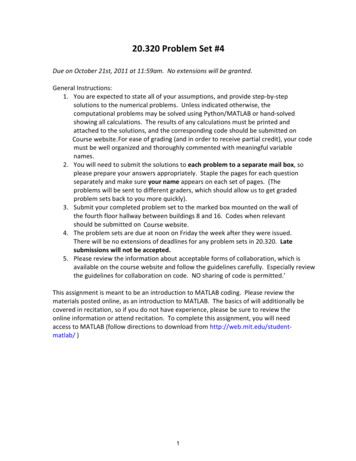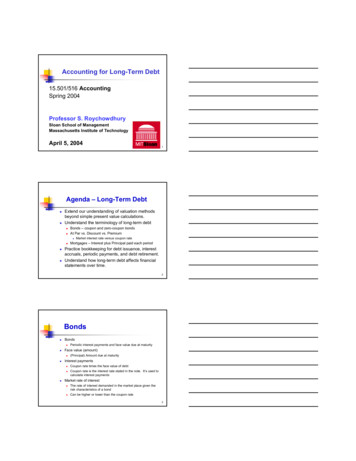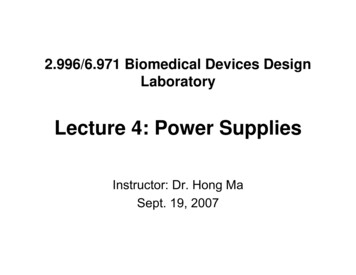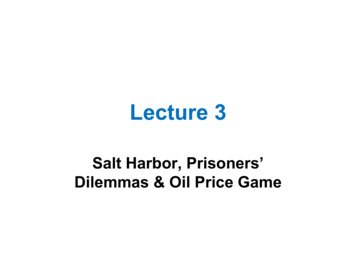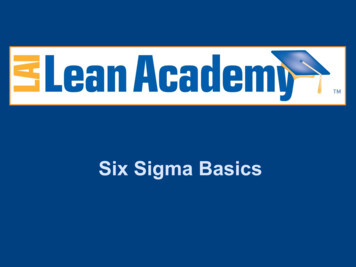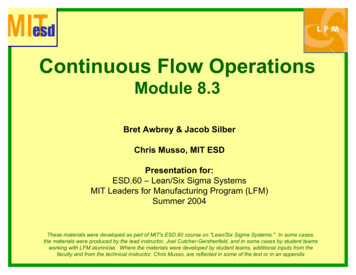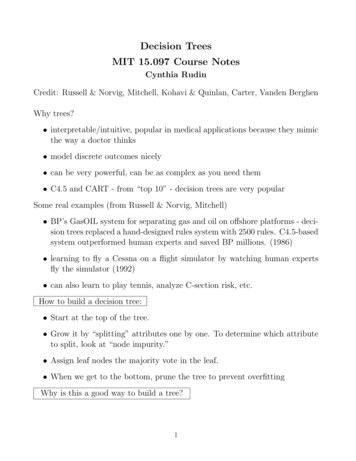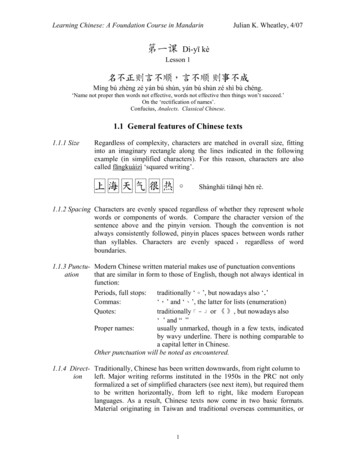
Transcription
Learning Chinese: A Foundation Course in Mandarin第一课Julian K. Wheatley, 4/07Dì-yī kèLesson 1名不正则言不顺,言不顺 则事不成Míng bú zhèng zé yán bú shùn, yán bú shùn zé shì bù chéng.‘Name not proper then words not effective, words not effective then things won’t succeed.’On the ‘rectification of names’.Confucius, Analects. Classical Chinese.1.1 General features of Chinese texts1.1.1 SizeRegardless of complexity, characters are matched in overall size, fittinginto an imaginary rectangle along the lines indicated in the followingexample (in simplified characters). For this reason, characters are alsocalled fāngkuàizì ‘squared writing’.上海天气很热。Shànghǎi tiānqì hěn rè.1.1.2 Spacing Characters are evenly spaced regardless of whether they represent wholewords or components of words. Compare the character version of thesentence above and the pinyin version. Though the convention is notalways consistently followed, pinyin places spaces between words ratherthan syllables. Characters are evenly spaced , regardless of wordboundaries.1.1.3 Punctu- Modern Chinese written material makes use of punctuation conventionsationthat are similar in form to those of English, though not always identical infunction:Periods, full stops:traditionally ‘。’, but nowadays also ‘.’Commas:‘,’ and ‘、’, the latter for lists (enumeration)Quotes:traditionally「-」 or 《 》, but nowadays also‘ ’ and “ ”Proper names:usually unmarked, though in a few texts, indicatedby wavy underline. There is nothing comparable toa capital letter in Chinese.Other punctuation will be noted as encountered.1.1.4 Direct- Traditionally, Chinese has been written downwards, from right column toionleft. Major writing reforms instituted in the 1950s in the PRC not onlyformalized a set of simplified characters (see next item), but required themto be written horizontally, from left to right, like modern Europeanlanguages. As a result, Chinese texts now come in two basic formats.Material originating in Taiwan and traditional overseas communities, or1
Learning Chinese: A Foundation Course in MandarinJulian K. Wheatley, 4/07on the Mainland prior to the reforms, is written with traditional charactersthat are – with a few exceptions such as in headlines and on forms –arranged vertically (top to bottom and right to left). Material originating inthe Mainland, in Singapore (again, with some exceptions for religious orspecial genres) and in some overseas communities,after the reforms ofthe 1950s,is written with simplified characters arranged horizontally, leftto right.(Chinese has provided the model for most of the scripts that writevertically – at least in East Asia. Vertical writing is still the norm in Japan,coexisting with horizontal writing. Other scripts of the region, such asMongolian, whose writing system derives ultimately from an Indianprototype, have also followed the traditional Chinese format.)1.2 The form of charactersCharacters are the primary unit for writing Chinese. Just as English letters may haveseveral forms (eg g /g, a/a) and styles (eg italic), so Chinese characters also have variousrealizations. Some styles that developed in early historical periods survive to this day inspecial functions. Seals, for example, are still often inscribed in the ‘seal script’, firstdeveloped during the Qin dynasty (3rd C. BCE). Other impressionistic, running scripts,developed by calligraphers, are still used in handwriting and art. Advertisements andshop signs may stretch or contort graphs for their own design purposes. Manga stylecomics animate onomatopoeic characters – characters that represent sound – inidiosyncratic ways. Putting such variants aside, it is estimated that the number ofcharacters appearing in modern texts is about 6-7000 (cf. Hannas 1997, pp 130-33, andparticularly table 3). Though it is far fewer than the number cited in the largest historicaldictionaries, which include characters from all historical periods, it is still a disturbinglylarge number.1.2.1 Radicals and phoneticsThere are ameliorating factors that make the Chinese writing system more learnable thanit might otherwise be. One of the most significant is the fact that characters have elementsin common; not just a selection of strokes, but also larger constituents. Between 2/3 and¾ of common characters (cf. DeFrancis 1984, p. 110 and passim) consist of twoelements, both of which can also stand alone as characters in their own right. Historically,these elements are either roots, in which case they are called ‘phonetics’, or classifiers, inwhich case they are called (paradoxically) ‘radicals’. Thus, 忘 wàng ‘forget’ contains 亡as phonetic and 心 as classifier; 語 yǔ ‘language’ has 吾 and 言. The significance of theterms phonetic and classifier will be discussed in a later unit. For now, it is enough toknow that the basic graphs are components of a large number of compound graphs: 亡appears in 忙 and 氓, for example; 心 in 志 and 忠; 言 in 謝 and 說; 吾 in 悟 and 晤.Even this set of component graphs numbers in the high hundreds, but familiarity withthem allows many characters to be learned as a pairing of higher order constituents ratherthan a composite of strokes.2
Learning Chinese: A Foundation Course in MandarinJulian K. Wheatley, 4/071.2.2 Simplified charactersChinese policy makers have also tried to make the writing system more learnable byintroducing the Chinese equivalent of spelling reform, which takes the form of reducingthe number of strokes in complicated characters: 國 becomes 国; 邊 becomes 边. Thetwo sets are usually called ‘traditional’ and ‘simplified’ in English, fántǐzì (‘complicatedbody-characters’) and jiǎntǐzì (‘simple-body-characters’) in Chinese.For almost 2000 years in China, serious genres of writing were written in thekǎishū script (‘model writing’) that first appeared in the early centuries of the firstmillennium. In the 1950s, the Mainland government, seeking to increase literacy,formalized a set of simplified characters to replace many of the more complicated of thetraditional forms. Many of these simplified characters were based on calligraphic andother styles in earlier use; but others were novel graphs that followed traditional patternsof character creation.For the learner, this simplification is a mixed blessing – and possibly no blessingat all. For while it ostensibly makes writing characters simpler, it also made them lessredundant for reading: 樂 and 東 (used to write the words for ‘music’ and ‘east’,respectively) are quite distinct in the traditional set; but their simplified versions, 乐 and东, are easy to confuse. Moreover, Chinese communities did not all agree on the newreforms. The simplified set, along with horizontal writing, was officially adopted by thePRC in the late 1950s and (for most purposes) by Singapore in the 1960s. But Taiwan,most overseas Chinese communities and, until its return to the PRC, Hong Kong, retainedthe traditional set of characters as their standard, along with vertical writing.Jiǎntǐzì and fántǐzì should not be thought of as two writing systems, for not onlyare there many characters with only one form (也 yě, 很 hěn, 好 hǎo, etc), but of thosethat have two forms, the vast majority exhibit only minor, regular differences, eg: 说/說,饭/飯. What remain are perhaps 3 dozen relatively common characters with distinctivelydivergent forms, such as: 这/這, 买/買. Careful inspection reveals that even they oftenhave elements in common. For native Chinese readers, the two systems represent only aminor inconvenience, rather like the difference between capital and small letters in theRoman alphabet, though on a larger scale. Learners generally focus on one system forwriting, but soon get used to reading in both.1.3 FunctionAs noted earlier, characters represent not just syllables, but syllables of particular words(whole words or parts of words). In other words, characters generally function aslogograms – signs for words. Though they can be adapted to the task of representingsyllables (irrespective of meaning), as when they are used to transliterate foreign personaland place names, when they serve this function they are seen as characters with theirmeanings suppressed (or at least, dimmed), eg: 意大利 Yìdàlì ‘Italy’, with the meanings‘intention-big-gain’ suppressed.3
Learning Chinese: A Foundation Course in MandarinJulian K. Wheatley, 4/07In practice, different words with identical sound (homophones) will usually bewritten with different ��Such homophony is common in Chinese at the syllable level (as the shi-story, describedin the preliminary chapter, illustrated). Here, for example, are some common words orword parts all pronounced shì (on falling tone):shì是 ‘be’事 ‘thing’室 ‘room’试 ‘test’.But except for high-frequency words (such as 是 shì ‘be’), words in Mandarin are usuallycompound, consisting of several syllables: 事情 shìqing ‘things’; 教室 jiàoshì‘classroom’; 考试 kǎoshì ‘examination’. At the level of the word, homophony is far rarer.In Chinese language word-processing where the input is in pinyin, typing shiqing andkaoshi (most input systems do not require tones) will elicit at most only two or threeoptions, and since most word processors organize options by frequency, in practice, thismeans that the characters for shiqing and kaoshi will often be produced on the first room’kǎoshì‘test’考试教室1.4 Writing1.4.1 Writing in the age of word processorsJust as in English it is possible to read well without being able to spell every word frommemory, so in Chinese it is possible to read without being able to write every characterfrom memory. And in fact, with the advent of Chinese word processing, it is evenpossible to write without being able to produce every character from memory, too; for ina typical word processing program, the two steps in composing a character text are, first,to input pinyin and, second, to confirm – by reading – the output character, or ifnecessary, to select a correct one from a set of homonyms (ordered by frequency).4
Learning Chinese: A Foundation Course in MandarinJulian K. Wheatley, 4/07There is, nevertheless, still a strong case to be made for the beginning studentlearning to write characters by hand. First of all, there is the aesthetic experience. In theChinese world, calligraphy – beautiful writing, writing beautifully – is valued not only asart, but also as moral training. Even if your handwriting never reaches gallery quality, thetactile experience and discipline of using a writing implement on paper (or even on atablet computer) is valuable. Writing also serves a pedagogical function: it forces you topay attention to details. Characters are often distinguished by no more than a singlestroke:4 strokes5 strokes天夭夫tiānskyyāofūquǎngoblin person shēn tiánwhite explain field犬太Learning to write characters does not mean learning to write all charactersencountered from memory, for the immense amount of time it takes to internalize thegraphs inevitably takes away from the learning of vocabulary, usage and grammaticalstructure. This course adopts the practice of introducing material in pinyin ratherexuberantly, then dosing out a subset to be read in characters. The balance of writing toreading is something to be decided by a teacher. In my view, at least in the early lessons,students should not only be able to read character material with confidence, but theyshould be able to write most of it if not from memory, then with no more than anoccasional glance at a model. The goal is to learn the principles of writing so that anycharacter can be reproduced by copying; and to internalize a smaller set that can bewritten from memory (though not necessarily in the context of an examination). Thesewill provide a core of representative graphs and frequently encountered characters forfuture calligraphic endeavors.1.4.2 Principles of drawing charactersStrokes are called bǐhuà(r) in Chinese. Stroke order (bǐshùn) is important for aestheticreasons – characters often do not look right if the stroke order is not followed. Followingcorrect stroke order also helps learning, for in addition to visual memory for characters,people develop a useful tactile memory for them by following a consistent stroke order.a) FormThere are usually said to be eight basic strokes plus a number of composites. They areshown below, with names for each stroke and examples of characters that contain them.héng ‘horizontal’一shù ‘vertical’十piě ‘cast aside’ ieleftwards slanting人nà ‘pressing down’ie rightwards slanting入5
Learning Chinese: A Foundation Course in Mandarintiǎo ‘poking up’ ierightward rising冷把小心弋买gōu ‘hook’[four variants, shown]Julian K. Wheatley, 4/07diǎn ‘dot’小熱zhé ‘bend’[many variants]马凸Composite strokes can be analyzed in terms of these eight, eg ‘horizontal plus leftwardsslant’.b) DirectionIn most cases, strokes are falling (or horizontal); only one of the eight primary strokesrises – the one called tiǎo.c) OrderThe general rules for the ordering of strokes are given below. These rules are not detailedenough to generate word order for you, but they will help you to make sense of the order,and to recall it more easily once you have encountered it. Begin here by drawing thecharacters shown below as you contemplate each of the rules, and recite the names of thestrokes:shíii) Except a closing héng is often post-wáng king; surname 王poned till last:iii) Left stroke before right:(eg piě before nà)iv) Top before bottom:v) Left constituent before right:(eg 土 before 也)10十i) Horizontal (héng) before vertical echdìplace八人木三言地kǒumouth口vi) Boxes are drawn in 3 strokes:the left vertical, then top and right,ending with bottom (left to right):6
Learning Chinese: A Foundation Course in Mandarinvii) Frame before innards:viii) Frames are closed last, after innards:Julian K. Wheatley, 4/07月国yuèmoon; monthguócountrysì4rìsun; daytiánfield四日田xiǎosmall小ix) For symmetrical parts, dominantprecedes mi
Learning Chinese: A Foundation Course in Mandarin Julian K. Wheatley, 4/07 . There is, nevertheless, still a strong case to be made for the beginning student learning to write characters by hand. First of all, there is the aesthetic experience. In the Chinese world, calligraphy – beautiful writing, writing beautifully – is valued not only as art, but also as moral training. Even if your .

